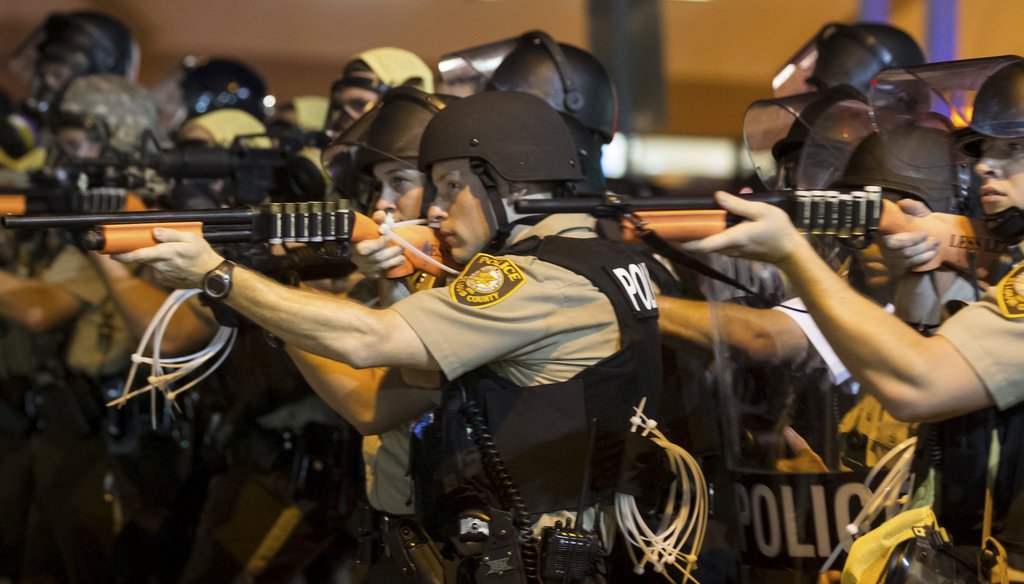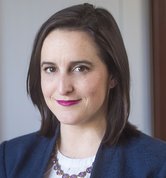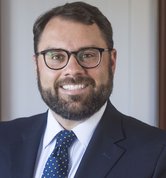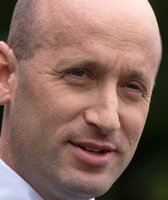Stand up for the facts!
Our only agenda is to publish the truth so you can be an informed participant in democracy.
We need your help.
I would like to contribute

Police aim their weapons and make their way down West Florissant Avenue, pushing protesters north on the street in Ferguson, Mo., the night of Aug. 18, 2014. (New York Times)
The killing of an unarmed black 18-year-old by a white police officer in a St. Louis suburb is raising questions about the makeup of the police department and its response to the Aug. 9 shooting.
Here are four fact-checks about the situation in Ferguson, Mo.
The chief’s wife
On Aug. 13, one of a handful of Twitter accounts claiming to be associated with the hacktivist group Anonymous posted comments they say came from the wife of Ferguson Police Chief Tom Jackson.
Speaking of people in Ferguson, a woman identified as Catherine Nardi wrote: "They are feral and violent. They murder each other. They murder their unborn babies. They murder white people. They hate police officers and murder some of them, even black ones. They destroy neighbors and entire cities with garbage and drugs. They live their lives off the hard-earned tax dollars of other Americans. Yet somehow they are victims. What insanity is that?"
The comments have been retweeted more than 7,000 times.
But they’re not from the police chief’s wife, PunditFact found out.
The person in the Facebook message, Catherine Nardi, lives in St. Petersburg, Fla., not Missouri, according to public records. She is married to Henry Nardi, who is not the police chief of Ferguson. We reached out to Nardi via Facebook, but she did not respond. A woman answering a phone number associated with her hung up on a reporter. (Nardi removed her Facebook profile after this fact-check first published.)
According to the St. Louis Post-Dispatch, Jackson’s wife is named Patricia, not Catherine.
We rated the claim Pants on Fire.
More on the police department
One of the claims PunditFact heard several times is that the majority of Ferguson’s residents are black, but black police officers make up just a sliver of city law enforcement.
"You've got three black officers and 50 white officers with a town that is 67 percent African-American," said Andrea Mitchell, who hosted Meet the Press on Aug. 17.
That claim is Mostly True.
The racial makeup of the police force emerged as a widely reported story line after the Aug. 9 fatal shooting of Michael Brown, 18, by white officer Darren Wilson, 28.
Mitchell’s statistic about Ferguson’s black population checks out through the city’s QuickFacts profile from the U.S. Census Bureau. As of 2010, 67.4 percent of the city’s 21,000 residents are black, and 29.3 percent are white.
Ferguson Police Chief Thomas Jackson, who is white, said the police department has 53 officers, three of whom are black, according to the Los Angeles Times and the Associated Press. He also said that the other 50 officers are white, according to newspaper reports. Put another way, Ferguson police officers are 94 percent white and 5.6 percent black.
Timothy Zoll, a spokesman for the Ferguson Police Department, told PunditFact that there actually are four African-American officers among the 53-person officer corps. "The discrepancy may have been that we really don't see black or white among our colleagues," Zoll said.
So there is some question whether the number is three or four, but there is no question that an imbalance exists.
Gov. Nixon’s response
The response of the police department is not the only issue that people are wanting to discuss. There are questions about the response of Missouri Gov. Jay Nixon, said ABC This Week host Martha Raddatz.
Interviewing Nixon on Aug. 17, Raddatz said, ""People are angry with you, personally. Your press briefings have been town halls, people venting their anger, wondering where you were early on. I know you issued statements after about 72 hours, but you didn't come to the scene for five days. What responsibility do you bear?"
Nixon replied: "Well, I mean, I've been here almost every day."
That’s not accurate, PolitiFact found.
Brown was shot Aug. 9 and violence broke out Aug. 10. Nixon first visited a nearby city on Aug. 12, but he didn’t visit Ferguson until Aug. 14.
While Nixon was active early — calling for a federal investigation the morning after a standoff between protesters and police and attending the nearby community meeting — there is a distinct and noticeable shift in Nixon’s activities starting Aug. 14.
Prior to that date, Nixon kept up his schedule and continued to make appearances unrelated to the Ferguson shooting. After that date, he held daily press conferences and meetings near the scene of the crime, visited the location of the shooting, and made no other official public appearances.
In all, he was in Ferguson for three days from Aug. 10 through Aug. 16, all toward the end of the week.
Nixon’s statement rates Mostly False.
Police militarization
On the Aug. 17 edition of his HBO show Last Week Tonight, John Oliver aired a segment about some of the problems spawned by police departments acquiring armor and other military-grade equipment in recent years.
Oliver used television clips to punctuate his argument that police departments have turned themselves into virtual military units. At one point, Oliver used a clip from Al Jazeera to offer a statistic that quantified the shift: "The number of SWAT raids have gone up by 1,400 percent since the 1980s."
The source of the statistic is research by Eastern Kentucky University justice studies professor Peter Kraska. Starting in the 1990s, Kraska conducted academic surveys of a sample of police departments in the United States. He asked for current data, as well as historical figures going back to 1980, his baseline year.
Here’s what Kraska wrote in a 2007 paper: "There has been more than a 1,400 percent increase in the total number of police paramilitary deployments, or callouts, between 1980 and 2000. Today, an estimated 45,000 SWAT-team deployments are conducted yearly among those departments surveyed; in the early 1980s there was an average of about 3,000. … The trend-line demonstrated that this growth began during the drug war of the late 1980s and early 1990s."
Kraska’s math is correct: An increase of 3,000 to 45,000 is indeed a 1,400 percent jump, as long as you consider the terms "callout" and "raid" to be equivalent.
This increase stemmed from two related trends. First, more police departments deployed SWAT-style teams for the first time. The percentage of larger departments that had such a unit doubled between the mid 1980s and the late 1990s, according to Kraska’s data, while the percentage of small departments rose even faster, quadrupling over a similar period.
Second, those units were deployed more frequently -- and for purposes well beyond the traditional SWAT realm of hostage, sniper and terrorist incidents. Kraska found that more than 80 percent of deployments were for drug raids, especially at private residences, where officers were looking to seize drugs, guns and money. Such units "had changed from being a periphery and strictly reactive component of police departments to a proactive force actively engaged in fighting the drug war," Kraska wrote.
So Oliver is on solid ground here by relying on academic research.
Still, it’s worth noting that the data ends in 2000, and we don’t know for sure what the level is today.
So PunditFact rates this claim Mostly True.
Steve Contorno and Louis Jacobson contributed to this report. Read the full fact-checks at PunditFact.com and PolitiFact.com.
Our Sources
See individual fact-checks.













































